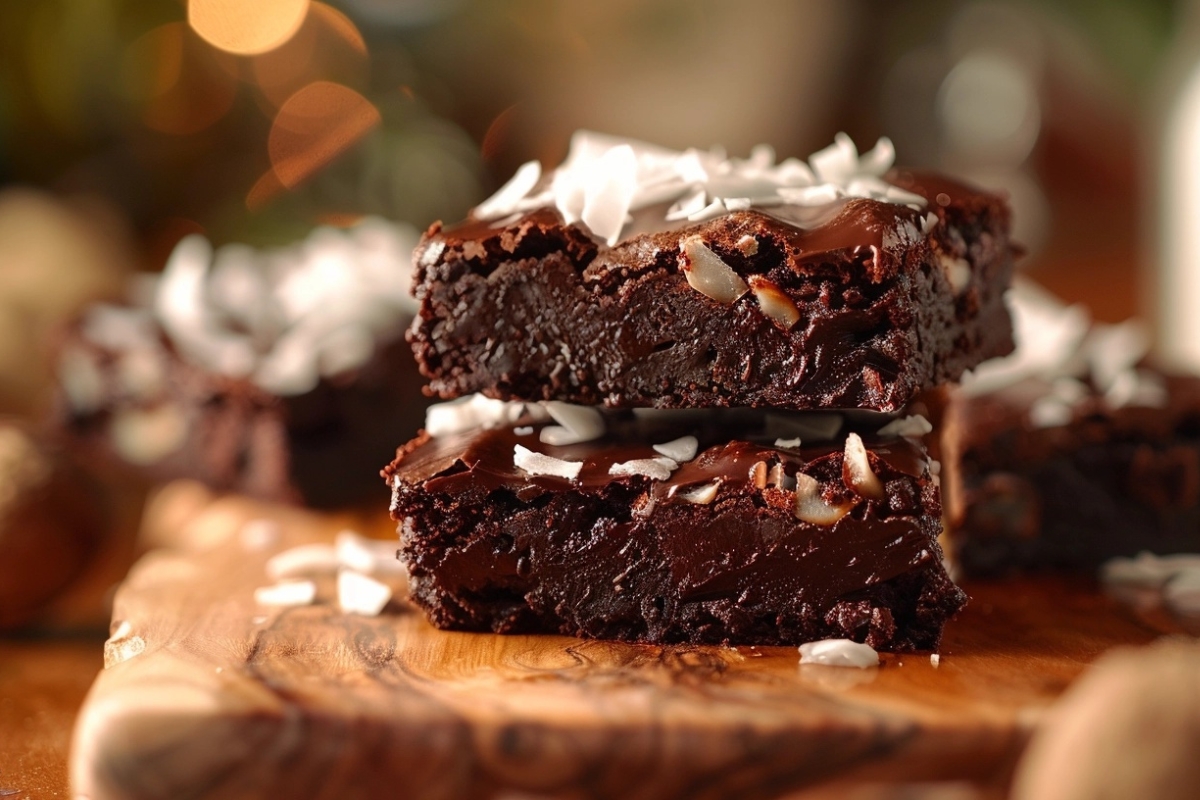Introduction
Brownies are a beloved dessert for many, known for their rich chocolate flavor and chewy, gooey texture. However, many home bakers encounter a frustrating problem when making brownies: they often end up with hard edges, even if the center remains perfectly soft. This issue can be disappointing, especially when you’ve followed the recipe to the letter. But why does this happen? More importantly, how can you prevent it?
In this comprehensive guide, we will explore the common causes of hard brownie edges and provide practical tips to help you achieve evenly baked, delicious brownies every time. Whether you’re a seasoned baker or a beginner, this article will equip you with the knowledge needed to master the art of brownie baking, ensuring that your brownies come out of the oven with soft edges and a perfectly gooey center.
1. Understanding the Problem
2. Common Causes of Hard Edges in Brownies
2.1 Overbaking
Overbaking is one of the most common reasons for hard brownie edges. Brownies are a delicate balance between gooey and firm, and even a few extra minutes in the oven can turn the edges dry and tough.
How to Avoid Overbaking:
- Check Early: Start checking your brownies for doneness a few minutes before the recommended baking time is up. Insert a toothpick into the center of the pan; if it comes out with a few moist crumbs attached, the brownies are done.
- Use a Timer: Always set a timer when baking to avoid accidentally leaving your brownies in the oven for too long.
- Reduce Baking Time: If you find that your brownies consistently turn out with hard edges, try reducing the baking time by 5-10 minutes. Brownies can be tricky, and your oven may bake hotter or faster than the recipe suggests.
2.2 Incorrect Pan Size or Type
The type and size of the pan you use can significantly impact how your brownies bake. Using the wrong pan can lead to uneven baking, causing the edges to cook faster than the center.
Impact of Different Pan Types:
- Glass Pans: Glass pans retain heat longer, which can cause the edges of your brownies to overcook while the center remains underbaked. While they are great for certain types of baking, glass pans can be tricky with brownies.
- Metal Pans: Metal pans, particularly light-colored ones, distribute heat more evenly and are generally better for baking brownies. They help prevent the edges from becoming too hard.
- Dark Metal Pans: These pans absorb more heat and can cause the brownies to bake too quickly, leading to hard edges. If you’re using a dark metal pan, consider reducing the oven temperature by 25°F (about 15°C).
Pan Size Considerations:
- If your recipe calls for an 8×8-inch pan and you use a larger one, the brownies will spread out thinner, causing them to bake more quickly. This can result in hard edges. Always use the pan size specified in the recipe to ensure even baking.
2.3 Uneven Heat Distribution
Uneven heat distribution in your oven can cause certain areas of your brownies to bake faster than others, leading to hard edges and an undercooked center.
How to Ensure Even Heat Distribution:
- Rotate the Pan: About halfway through the baking time, rotate the pan to help the brownies bake more evenly. This simple step can prevent one side of the pan from getting too much heat.
- Use an Oven Thermometer: Oven temperatures can vary, and even a small difference can impact your baking. An oven thermometer ensures that your oven is at the correct temperature, helping you avoid overbaked edges.
2.4 Ingredient Imbalance
The balance of wet and dry ingredients in your brownie batter plays a crucial role in how the brownies bake. If the batter is too dry, the edges will harden during baking.
Tips for Ingredient Balance:
- Measure Carefully: Always measure your ingredients carefully, especially flour. Too much flour can absorb moisture, leading to dry, hard edges. On the other hand, too little fat can also cause the brownies to dry out.
- Adjust for Humidity: In humid climates, flour can absorb moisture from the air, which may require you to use slightly less flour than the recipe calls for. Conversely, in dry climates, you might need to add a bit more moisture to your batter.
2.5 High Oven Temperature
Baking brownies at a high temperature can cause the edges to set and harden before the center is fully cooked. This is especially common if your oven runs hotter than the temperature indicated on the dial.
How to Adjust Temperature:
- Lower the Temperature: If you consistently struggle with hard edges, try lowering your oven temperature by 25°F (about 15°C). This will slow down the baking process and allow the brownies to cook more evenly.
- Use a Lower Rack: Baking on a lower rack can help prevent the top and edges from browning too quickly, allowing the center to catch up.
3. Techniques to Prevent Hard Edges
3.1 Proper Use of Oven Thermometers
One of the easiest ways to ensure that your brownies bake evenly is to use an oven thermometer. Even if your oven has a built-in thermometer, it may not be accurate. An oven thermometer allows you to monitor the actual temperature and adjust as needed.
Why It’s Important:
- Consistency: An accurate temperature ensures that your brownies bake evenly, reducing the likelihood of hard edges.
- Prevent Overheating: Ovens can sometimes run hotter than their settings, causing your brownies to overbake. Monitoring the temperature helps prevent this.
3.2 Adjusting Baking Time
Baking time is crucial for achieving the perfect texture in brownies. If you find that your brownies consistently turn out with hard edges, try reducing the baking time.
How to Adjust:
- Start Checking Early: As mentioned earlier, start checking your brownies a few minutes before the recommended baking time. Every oven is different, and slight variations in temperature can affect baking times.
- Use the Toothpick Test: When the edges are set but the center still has a few moist crumbs on a toothpick, it’s time to take the brownies out of the oven.
3.3 Using the Right Baking Pan
Choosing the right pan for baking brownies can make a significant difference in the final texture. As discussed, different materials conduct heat differently, affecting how the brownies bake.
Recommended Pans:
- Light-colored Metal Pans: These pans are ideal for baking brownies as they distribute heat evenly, preventing hard edges.
- Avoid Glass and Dark Metal Pans: These pans can cause the edges to cook faster than the center, leading to uneven baking.
3.4 Lining the Pan
Lining your baking pan with parchment paper or aluminum foil can help prevent hard edges by creating a barrier between the brownies and the hot pan.
How to Line Your Pan:
- Use Parchment Paper: Cut a piece of parchment paper to fit the bottom and sides of the pan. This not only helps with even baking but also makes it easier to remove the brownies from the pan without damaging them.
- Leave an Overhang: Leave a bit of parchment paper overhanging on the sides to act as handles for lifting the brownies out of the pan once they are cooled.
3.5 Lowering Oven Temperature
If you find that your brownies are still developing hard edges despite following the above tips, try lowering your oven temperature by 25°F (about 15°C). A lower temperature allows the brownies to bake more slowly and evenly, reducing the risk of hard edges.
Why Lowering the Temperature Helps:
- Gentler Baking: A lower temperature helps the brownies bake evenly, allowing the center and edges to cook at the same rate.
- Preventing Overbaking: Lower temperatures reduce the chances of the edges drying out while waiting for the center to finish baking.
3.6 Monitoring Bakeware Placement
Where you place your bakeware in the oven can also impact the final outcome. Placing the pan too close to the heat source can cause the edges to cook faster than the center.
Placement Tips:
- Center Rack: Position your brownies on the center rack of the oven to ensure even baking. If your oven has hotspots, consider rotating the pan halfway through baking.
- Avoid Bottom Rack: Baking on the bottom rack can cause the bottom and edges of the brownies to cook too quickly, leading to hard edges.
3.7 Cooling Techniques
Cooling your brownies properly is just as important as baking them correctly. Leaving them in the hot pan can cause the edges to continue cooking, resulting in hard edges.
Cooling Tips:
- Remove from Pan: Once the brownies are done baking, remove them from the pan as soon as they are cool enough to handle. This prevents the residual heat from continuing to cook the edges.
- Use a Cooling Rack: Place the brownies on a cooling rack to allow air to circulate around them, preventing the edges from hardening.
4. Troubleshooting Hard Edges After Baking
Even with the best techniques, sometimes your brownies may still develop hard edges. Fortunately, there are ways to salvage them.
4.1 Softening Hard Brownie Edges
If your brownies have already developed hard edges, there are a few tricks you can use to soften them:
Methods to Soften Hard Edges:
- Microwave with a Damp Towel: Place a damp paper towel over the brownies and microwave for 10-15 seconds. The moisture from the towel will help soften the edges.
- Reheat in the Oven: Wrap the brownies in aluminum foil and place them in a 300°F (150°C) oven for about 5 minutes. The steam created inside the foil will soften the edges.
4.2 Repurposing Hard Brownies
If softening the brownies doesn’t work, consider repurposing them. Hard brownies can still be delicious when used creatively in other desserts.
Creative Uses for Hard Brownies:
- Brownie Crumbs: Crumble the hard brownies and use them as a topping for ice cream, yogurt, or pudding.
- Brownie Milkshake: Blend the hard brownies with ice cream and milk to create a decadent brownie milkshake.
- Brownie Trifles: Layer brownie crumbs with whipped cream and fruit to make a trifle.
5. Frequently Asked Questions (FAQ)
What Makes Brownies Hard Around the Edges?
Brownies typically become hard around the edges due to overbaking, incorrect pan choice, or uneven heat distribution. Ensuring even baking and monitoring your oven temperature can help prevent this common issue.
How Do I Know When Brownies Are Done Baking?
Use the toothpick test: insert a toothpick into the center of the brownies, and if it comes out with a few moist crumbs, they are done. The edges should be set, but the center should still be slightly gooey.
Can Using Foil Instead of Parchment Paper Cause Hard Edges?
Foil can conduct heat more intensely than parchment paper, potentially contributing to hard edges. If you prefer using foil, make sure to monitor the brownies closely and adjust baking time accordingly.
Is There a Way to Avoid Hard Edges When Baking Brownies in a Convection Oven?
In a convection oven, heat circulates more efficiently, which can lead to quicker baking times and harder edges. Lower the baking temperature by 25°F (about 15°C) and reduce the baking time to prevent hard edges.
Conclusion
Achieving the perfect brownie with soft, gooey centers and no hard edges requires attention to detail and an understanding of how various factors affect the baking process. By adjusting your baking time, temperature, and pan choice, you can significantly reduce the chances of ending up with hard-edged brownies. Whether you’re baking for a special occasion or just satisfying a chocolate craving, these tips will help you create the perfect batch every time.
For more baking tips, check out our Ultimate Chicken Salad Sandwiches Recipes & Tips or explore a sweet treat like Mounds Brownies: A Deliciously Decadent Chocolate Coconut Treat.

